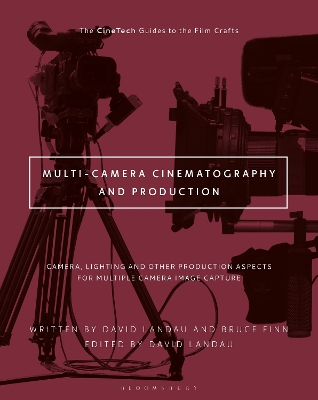The CineTech Guides to the Film Crafts
2 total works
We can't shoot good pictures without good lighting, no matter how good the newest cameras are. Shooting under available light gives exposure, but lacks depth, contrast, contour, atmosphere and often separation. The story could be the greatest in the world, but if the lighting is poor viewers will assume it's amateurish and not take it seriously. Feature films and TV shows, commercials and industrial videos, reality TV and documentaries, even event and wedding videos tell stories. Good lighting can make them look real, while real lighting often makes them look fake.
Lighting for Cinematography, the first volume in the new CineTech Guides to the Film Crafts series, is the indispensable guide for film and video lighting. Written by veteran gaffer and cinematographer David Landau, the book helps the reader create lighting that supports the emotional moment of the scene, contributes to the atmosphere of the story and augments an artistic style. Structured to mimic a 14 week semester, the chapters cover such things as lighting for movement, working with windows, night lighting, lighting the three plains of action and non-fiction lighting. Every chapter includes stills, lighting diagrams and key advice from professionals in the field, as well as lighting exercises to help the reader put into practice what was covered.
www.lightingforcinematography.com
Lighting for Cinematography, the first volume in the new CineTech Guides to the Film Crafts series, is the indispensable guide for film and video lighting. Written by veteran gaffer and cinematographer David Landau, the book helps the reader create lighting that supports the emotional moment of the scene, contributes to the atmosphere of the story and augments an artistic style. Structured to mimic a 14 week semester, the chapters cover such things as lighting for movement, working with windows, night lighting, lighting the three plains of action and non-fiction lighting. Every chapter includes stills, lighting diagrams and key advice from professionals in the field, as well as lighting exercises to help the reader put into practice what was covered.
www.lightingforcinematography.com
Multi-Camera Cinematography and Production
by David Landau and Bruce Finn
Published 28 December 2023
A how-to book on the art, craft and practice of TV/video/streaming cinematography for multi-camera shooting.
This book is written for anyone wanting to film, direct or produce multiple camera productions. Lighting Directors, Directors of Photography, Camera Operators as well as Directors, Producers and Production Managers will all find valuable information that will help them do their job and accomplish their goals of effectively filming with more than one camera at the same time. This book could be seen as an intermediate to advanced media production course book for colleges. It is also meant to give insight and inspiration to those starting out their professional careers in multi-camera productions.
The text covers advice for producing and filming content using two or more cameras in many genres including Sitcom, Stand-up, News, Talk Show, Interview, Reality, Corporate Video and Indie Movies, with budgets both big and small, by two award winning professional industry cinematographers/lighting directors with over 30 years of experience each.
This book is written for anyone wanting to film, direct or produce multiple camera productions. Lighting Directors, Directors of Photography, Camera Operators as well as Directors, Producers and Production Managers will all find valuable information that will help them do their job and accomplish their goals of effectively filming with more than one camera at the same time. This book could be seen as an intermediate to advanced media production course book for colleges. It is also meant to give insight and inspiration to those starting out their professional careers in multi-camera productions.
The text covers advice for producing and filming content using two or more cameras in many genres including Sitcom, Stand-up, News, Talk Show, Interview, Reality, Corporate Video and Indie Movies, with budgets both big and small, by two award winning professional industry cinematographers/lighting directors with over 30 years of experience each.

